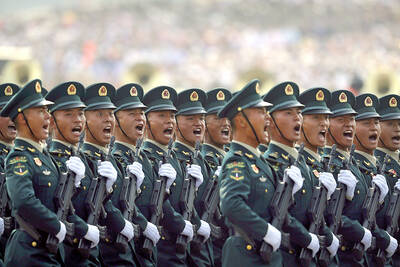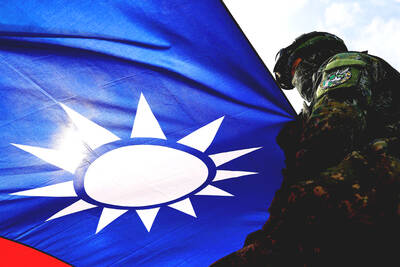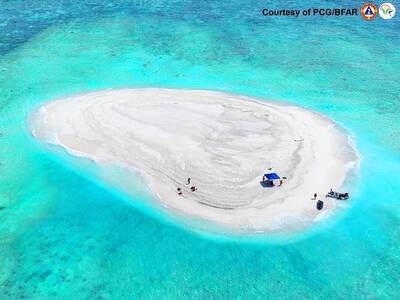The passage of two US guided missile destroyers through the Taiwan Strait on Saturday was not an isolated incident, but a signal of the expansion of the US’ military presence in the region, Institute for National Policy Research executive director Kuo Yu-jen (郭育仁) said yesterday.
US forces in Japan and Guam are to expand their reach to the south and west respectively, he said, adding that the US military is likely to normalize naval drills around Taiwan as a check on China.
Kuo’s comments came after the Ministry of National Defense on Saturday evening took the unusual step of publicizing the transit by the US Navy’s Arleigh Burke-class destroyers USS Benfold and USS Mustin through the Taiwan Strait earlier that day on an apparent northeasterly course.
Kuo said the move should not be seen as an exception or isolated event, but instead as a warning to China from the US that follows on the heels of recent setbacks in US-China relations.
From bilateral trade to North Korea, the South China Sea and the Taiwan Strait, the zero-sum game has become the prevalent scenario in US-China interactions, he said.
Prior to the summit between US President Donald Trump and North Korean leader Kim Jong-un last month, rumors of US plans to take action in the South China Sea abounded, he said.
At informal dialogues, US officials have told allies that Washington would counter Beijing in the South China Sea, lest China bring it into its sphere of control, he said.
Despite protests from China’s Taiwan Affairs Office, the transit was not the US “playing the Taiwan card,” but a statement on the South China Sea, he said.
A slew of military drills and actions from the US indicates Washington’s commitment to counter and exert pressure on China, he said.
For instance, the US carrier strike group led by the Nimitz-class carrier USS Ronald Reagan is to conduct an aircraft launch and recovery exercise in the seas east of Taiwan, he said.
The purpose of the drill, according to the US Navy, is to maintain regional peace and stability, and to protect the common maritime interests of the US and its allies in the Indo-Pacific region, he said.
Additionally, Washington has announced various measures related to security cooperation with Taiwan, he said.
The signs indicate that US forces in Japan, especially the navy, would expand their activities from the Sea of Japan (known as the “East Sea” in South Korea) southward, while US forces in Guam would project westward, concurrently with the normalization of naval drills in the vicinity of Taiwan, he said.
Those drills are most likely to take place in the first and second island chain and South China Sea, he said.
Experience indicates China would do no more than try to head off US ships conducting freedom of navigation operations and its actions have so far been restrained, because it is not yet prepared to engage the US militarily in the South China Sea, he said.
“Escalating the situation accidentally is disadvantageous to China and they are not that stupid,” he said.
As the US steps up the scale and frequency of its activities in the South China Sea and more countries, such as Japan, Vietnam, India, Australia, the UK and France, become involved, risks in the region would increase, he said.
In particular, the lack of trust between China and Vietnam is a risk factor, Kuo said, adding that overall, he is pessimistic about peace in the South China Sea, but that he is more confident about the Taiwan Strait.
Yasuhiro Matsuda, professor of international politics at the University of Tokyo’s Institute for Advanced Studies on Asia, said that the US is within its rights under international law to sail warships near Taiwan, adding that the political message is clear.
“This is only a beginning,” Matsuda said. “The US is sending China a warning about its military expansion: Enough is enough, or the US has many other tricks left in its bag that it can be doing.”
That Taiwan announced the whereabouts of US ships showed that the two countries have a close working relationship and it sends a positive message to other US allies in the region, Matsuda added.
Meanwhile, a national security official yesterday said on condition of anonymity that the Taiwanese government received advanced information of the destroyers’ bearing, was constantly apprised of their whereabouts and did not issue the statement until well after the ships had left.
The USS Ronald Reagan’s drills to the east of Taiwan is a response to Chinese warships’ penetration of the first island chain and a reaffirmation of US commitment to Taiwan’s defense, the official said.
Additional reporting by Su Yung-yao

MORE VISITORS: The Tourism Administration said that it is seeing positive prospects in its efforts to expand the tourism market in North America and Europe Taiwan has been ranked as the cheapest place in the world to travel to this year, based on a list recommended by NerdWallet. The San Francisco-based personal finance company said that Taiwan topped the list of 16 nations it chose for budget travelers because US tourists do not need visas and travelers can easily have a good meal for less than US$10. A bus ride in Taipei costs just under US$0.50, while subway rides start at US$0.60, the firm said, adding that public transportation in Taiwan is easy to navigate. The firm also called Taiwan a “food lover’s paradise,” citing inexpensive breakfast stalls

US PUBLICATION: The results indicated a change in attitude after a 2023 survey showed 55 percent supported full-scale war to achieve unification, the report said More than half of Chinese were against the use of force to unify with Taiwan under any circumstances, a survey conducted by the Atlanta, Georgia-based Carter Center and Emory University found. The survey results, which were released on Wednesday in a report titled “Sovereignty, Security, & US-China Relations: Chinese Public Opinion,” showed that 55.1 percent of respondents agreed or somewhat agreed that “the Taiwan problem should not be resolved using force under any circumstances,” while 24.5 percent “strongly” or “somewhat” disagreed with the statement. The results indicated a change in attitude after a survey published in “Assessing Public Support for (Non)Peaceful Unification

PLUGGING HOLES: The amendments would bring the legislation in line with systems found in other countries such as Japan and the US, Legislator Chen Kuan-ting said Democratic Progressive Party (DPP) Legislator Chen Kuan-ting (陳冠廷) has proposed amending national security legislation amid a spate of espionage cases. Potential gaps in security vetting procedures for personnel with access to sensitive information prompted him to propose the amendments, which would introduce changes to Article 14 of the Classified National Security Information Protection Act (國家機密保護法), Chen said yesterday. The proposal, which aims to enhance interagency vetting procedures and reduce the risk of classified information leaks, would establish a comprehensive security clearance system in Taiwan, he said. The amendment would require character and loyalty checks for civil servants and intelligence personnel prior to

The China Coast Guard has seized control of a disputed reef near a major Philippine military outpost in the South China Sea, Beijing’s state media said, adding to longstanding territorial tensions with Manila. Beijing claims sovereignty over almost all of the South China Sea and has waved away competing assertions from other countries as well as an international ruling that its position has no legal basis. China and the Philippines have engaged in months of confrontations in the contested waters, and Manila is taking part in sweeping joint military drills with the US which Beijing has slammed as destabilizing. The Chinese coast guard